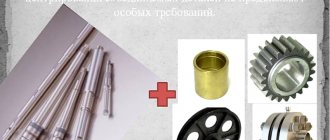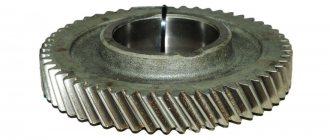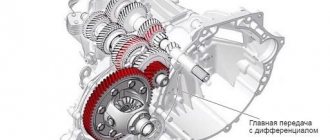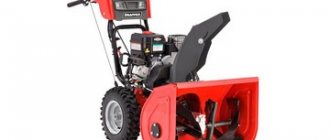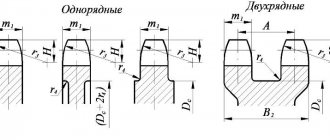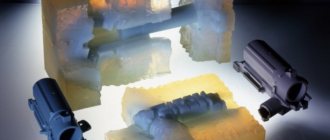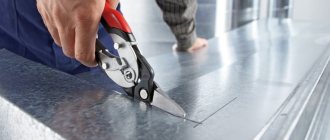The subsection contains information about drive and traction chains. Drive chains are used to transmit mechanical energy over medium distances between parallel shafts. Compared to belt drives, chain drives are smaller in size and provide a constant gear ratio, as they operate without slipping. To facilitate the selection of drive roller chains, the table of main parameters includes the projection areas of the bearing surfaces of the hinges. Traction chains are used as a traction element in various conveyors.
Description of chain transmission
A chain transmission is a transmission consisting of two sprocket wheels connected by a chain (Fig. 13). The rotation of the drive sprocket is converted into rotation of the driven sprocket due to the engagement of the chain with the sprocket teeth. It can have both a constant and variable gear ratio (for example, a chain variator).
Rice. 1 — Chain transmission device
The chain consists of moving links. The ends of the chain are connected into a closed ring to transmit continuous rotational motion using a special collapsible link.
As a rule, they try to make the number of teeth on sprockets and the number of chain links mutually simple, which ensures uniform wear: each sprocket tooth works in turn with all chain links.
Classification
The main classification of chain drives is based on the chain used. Highlight:
- Roller. The contact between the link and the gear is carried out by means of a roller, which simultaneously fastens the links.
- Bushings. The contact is made through a bushing rotating around the roller. This solution increases the service life of the chain drive, but at the same time its weight and cost increase.
- Serrated. They are assembled from articulated plates, on the inside of which there are profiled cavities for the teeth.
In addition, based on the number of gears mounted on the shaft and, accordingly, the number of parallel rows in one link, the following types are distinguished:
- single row;
- double row;
- multi-row.
Increasing the number of gears is used to increase power or to reduce the dimensions of the product.
Advantages of chain drives
Compared to belt drives, they are characterized by the following advantages:
- no slippage;
- compactness (take up significantly less space in width);
- constancy of the average gear ratio;
- absence of pre-tension and associated additional loads on shafts and bearings;
- high power transmission at both high and low speeds;
- maintaining satisfactory performance at high and low temperatures;
- adaptation to any design changes by removing or adding links.
- the ability to transmit movement by one chain to several sprockets;
- compared to gears - the ability to transmit rotational motion over long distances (up to 7 m);
- relatively high efficiency (> 0.9 ÷ 0.98);
- Possibility of easy chain replacement.
GEAR
Products belonging to this category consist of two types of plates:
- Basic. They mate with the sprocket teeth due to flat surfaces.
- Guides. The chain is centered relative to the “sprockets”, which have a groove located in the middle of the crown.
Compared to roller ones, gear ones allow you to achieve higher operating speeds. They are also distinguished by their smooth running and reliability. This is achieved through a multi-plate design. At the same time, they weigh more, are more difficult to produce, and are more expensive.
Different types of toothed chains are distinguished by the design features of the hinge. The most often used is a rolling joint; it is characterized by the absence of a roller; the liners consist of two segments. When the plates move, they roll, this mechanism increases the efficiency and service life of the product.
Less common are designs with a sliding hinge. The inserts in them are fixed on plates along the width of the chain and interact directly with the roller. They allow the plates to be rotated up to 30 degrees in both directions.
Disadvantages of chain drives
- elongation of the chain due to wear of its hinges and stretching of the plates;
- relatively high cost of chains;
- inability to use gear when reversing without stopping;
- transmissions require installation on crankcases;
- the supply of lubricant to the chain joints is difficult, which reduces the service life of the transmission.
- the chain speed, especially with a small number of sprocket teeth, is not constant, which causes fluctuations in the gear ratio.
- the chain consists of individual links and is located on the sprocket not in a circle, but in a polyhedron, which causes noise and additional dynamic loads;
Flaws
The disadvantages of chain drives include the following:
- high noise caused by constant collisions of drive parts;
- rapid wear of the articulated joints, the need for constant lubrication and a closed crankcase;
- stretching as the hinge joints wear out;
- less smooth rotation transmission than gear drives.
For certain applications, the advantages of this type of drive significantly outweigh its disadvantages
Circuit classification
By purpose:
- drive chains
- traction chains
- load chains.
In some mechanisms, lifting chains, such as hand-operated chain hoists, act as drive chains.
Drive chains are classified according to their design:
- roller,
- bushing,
- gear,
- shaped.
Roller drive chains
The chain is engaged with the sprocket through a freely rotating hardened roller, which, turning on the bushing, rolls along the tooth of the sprocket, forming a sliding hinge. This design allows you to equalize the pressure of the tooth on the bushing and reduce wear on both the bushing and the tooth.
The plates are outlined with a contour resembling the number 8 and ensuring equal strength of the plate in all sections. Roller chains are widely used. They are used at speeds v ≤ 15 m/sec.
Drive roller chains are produced in accordance with GOST 13568-75. There are:
- single-row normal (PR),
- single-row long-link lightweight (LRD),
- single-row reinforced (PRU),
- double row (2PR),
- three-row (ZPR),
- four-row (4PR),
- with curved plates (PRI).
Of the single-row roller chains, normal PR are the most common. Long-link lightweight PRD chains are manufactured with a reduced breaking load; the permissible speed for them is up to 3 m/sec. Reinforced PRU chains are manufactured with increased strength and accuracy; they are used under large and variable loads, as well as at high speeds.
Multi-row chains allow the load to be increased in proportion to the number of rows, so they are used when transmitting large powers. Roller chains with curved plates of increased compliance are used under dynamic loads (impacts, frequent reverses, etc.).
Rice. 2 - Single and double row roller chains
Bush drive chains
Bush drive chains are similar in design to roller chains, but do not have rollers, which reduces the cost of the chain, reduces its weight, but significantly increases the wear of chain bushings and sprocket teeth.
A single-row bushing chain (see Fig. 3) consists of internal plates pressed onto bushings that rotate freely on rollers on which outer plates are pressed. Depending on the transmitted power, drive bushing chains are made single-row (PV) and double-row (2PV). These chains are simple in design, light in weight and the cheapest, but less wear-resistant, so their use is limited to low speeds, usually up to 10 m/sec.
Bushing and roller chains are made single-row and multi-row with the number of rows 2, 3, 4 or more. A multi-row chain with a smaller pitch t makes it possible to replace a single-row chain with a larger pitch and thereby reduce the diameters of sprockets and reduce dynamic loads in the transmission. Multi-row chains can operate at significantly higher chain speeds. The load capacity of the chain increases almost in direct proportion to the number of rows.
The ends of the chain are connected with an even number of links using a connecting link, and with an odd number, with a less strong transition link with curved plates. Therefore, chains with an even number of links are used.
Single-row and double-row bushing chains of the PV type are produced in accordance with GOST 13568-75.
Rice. 3 — Single-row and double-row bushing chains type PV
Traction leaf chains
Traction leaf chains (bushing and roller) are produced in accordance with GOST 588-81; This GOST applies to traction plate bushings, roller and roller chains (with smooth rollers and plain bearings) used in hoisting and transport machines and other mechanisms.
Drive chains
Drive toothed chains are produced in accordance with GOST 13552-81. These chains operate smoothly, with little noise, provide high kinematic transmission accuracy due to uniform pitch changes during operation, and have increased reliability. Toothed chains consist of a set of tooth-shaped plates, hingedly connected to each other. The number of plates determines the width of the chain, which depends on the transmitted power. The working faces of the plates are the planes of the teeth located at an angle of 60°, with which each chain link sits on two sprocket teeth. Thanks to this feature, toothed chains have the smallest possible pitch and therefore allow higher speeds. To eliminate the lateral drop of the chain from the sprocket, guide plates are used, located in the middle of the chain or on its sides. Toothed chains, compared to others, operate more smoothly, with less noise, and absorb shock loads better, but are heavier and more expensive.
Rice. 4 - Toothed chain
Shaped link chains
There are two types of shaped link chains:
- hook;
- pin.
The hook chain consists of links of the same shape, cast from malleable cast iron or stamped from 30G strip steel without additional parts. Assembly and disassembly of this chain is carried out by mutually tilting the links at an angle of 60°.
In a pin chain, cast links made of ductile cast iron are connected by pinned steel (made of St3 steel) pins.
Shaped link chains are used when transmitting small powers, at low speeds (hook - up to 3 m/s, pin - up to 4 m/s), usually in conditions of imperfect lubrication and protection. The links of shaped chains are not processed. Due to their low cost and ease of repair, shaped link chains are widely used in agricultural machines.
Chain transmissions. Characteristic. Types of drive chains. Symbol.
Operating principle and comparative assessment. Chain transmission is based on the engagement of chain 1 and sprockets 2. The principle of engagement rather than friction, as well as the increased strength of a steel chain compared to a belt, allows the chain to transmit, all other things being equal, large loads (however less than gears). The absence of slipping and slipping ensures a constant gear ratio and the ability to work under significant short-term overloads. The gearing principle does not require pre-tensioning of the chain, which reduces the load on the shafts and supports. The angle around the sprocket with the chain is not as critical as the angle around the pulley with the belt. Therefore, chain transmissions can operate at smaller center distances and at large gear ratios, and also transmit power from one drive shaft 1 to several driven shafts 2 (Fig. 13.2).
Rice. 13.1 Fig. 13.2
Chain drives also have disadvantages. The main reason for these shortcomings is that the chain consists of individual rigid links and is located on the sprocket not in a circle, but in a polygon. This is associated with wear of the chain joints, noise and additional dynamic loads, and the need to organize a lubrication system.
area . Chain drives are used for significant interaxle distances, as well as for transmitting motion from one drive shaft to several driven ones in cases where gear drives are not applicable and belt drives are not reliable enough. Chain transmissions are most widespread in agricultural, transport and chemical engineering, machine tool building, mining equipment and lifting and transport devices.
They can operate in the ranges: P<5000 kW; K<35 m/s; /<10;a<8m.
1.
§ 13.2. Main characteristics
Power
Р=f/v (13.1)
Modern chain transmissions are used in the power range from fractions to several thousand kilowatts. Transmissions up to 100 kW are most widespread, since at higher powers the cost of a chain transmission progressively increases compared to a gear transmission.
Chain speed and sprocket speed
V=nzp/60 (13.2)
where 2 is the number of sprocket teeth; рп—chain pitch, m; and — sprocket rotation frequency, min”1.
Chain speed and sprocket rotation speed are associated with wear, noise and dynamic loads of the drive. The most widespread are low-speed and medium-speed transmissions with V up to 15 m/s and p up to 500 min-1. However, there are transmissions from n to 3000 min."1. With high-speed engines, the chain drive is usually installed after the gearbox.
Gear ratio
i=n1/n2=z2/z1 (13.3)
Common values of i are up to 6. For large values of i, it becomes impractical to perform a single-stage transmission due to its large dimensions.
Transmission efficiency. Losses in the chain drive consist of friction losses in the chain hinges, on the teeth of the sprockets and in the shaft supports. When lubrication by immersing the chain in an oil bath, oil mixing losses are also taken into account. The average efficiency value is “0.96...0.98.
Center distance and chain length. The minimum center distance is limited by the minimum permissible gap between the sprockets (30...50 mm):
Amin = (d1+d2)/2+(30…50),
where d is the outer diameter of the sprocket.
For reasons of chain durability (see below), in practice it is recommended to take
a = (30…50)/pc. (13.5)
Lower values for small i=1…2 and upper values for large i=6…7.
The length of the chain, expressed in steps or number of chain links,
This formula is derived similarly to the formula for belt length and is approximate. The lp value is rounded to a whole number, which is preferably even, so as not to use special connecting links. For the accepted value of lp, the value of a is specified. From the formula we have
The transmission works better with a slight slack in the idle chain branch. Therefore, it is recommended to reduce the calculated center distance by approximately (0.002...0.004) a. The length of the chain increases as the joints wear (see below), so the design* must include special devices to regulate the sag of the chain. This is usually achieved by moving the supports of one of the Shafts or installing special tension sprockets.
Drive chains. The main types of modern drive chains are articulated roller, bushing and toothed chains. They are standardized and manufactured by specialized factories. The main characteristics of the chain are pitch, width and breaking load.
The roller chain is shown in Fig. 13.3, a—single-row, in Fig. 13.3.6—two-row. Here, roller 3 is pressed into the hole of outer link 2, and bushing 4 is pressed into the hole of inner link 7. The bushing on the roller and roller 5 on the bushing can rotate freely. The chain engages with the sprocket tooth b through the roller. The use of a bushing allows you to distribute the load along the entire length of the roller and thereby reduce wear on the hinges. Rolling a roller over a tooth partially replaces sliding friction with rolling friction, which reduces tooth wear. In addition, the roller equalizes the concentrated pressure of the tooth on the bushing and thereby reduces its wear.
Roller chains are used at peripheral speeds of up to 20 m/s. Along with single-row ones, two-, three- and four-row chains are made (Fig. 13.3,6). They are assembled from the same elements, only the roller goes through all the rows. Multi-row chains allow the load to increase almost proportionally to the number of rows. Such chains are used for heavy loads in combination with high speeds: In these cases, it is not advisable to use single-row heavy chains with large pitches due to high dynamic loads.
Bush chains are similar in design to roller chains, but they do not have a roller 5. As a result, wear on the chain and sprockets increases, but the weight and cost of the chain are reduced.
Toothed chains (Fig. 13.4, a, b) consist of a set of plates with two tooth-like protrusions. The chain plates engage the sprocket teeth with their end planes. The wedging angle ($ is assumed to be 60°. The design of the gear
chains allows them to be made wide and transfer large loads. Toothed chains operate smoothly with less noise. They are recommended for use at relatively high speeds—up to 35 m/s.
Known toothed chains are distinguished mainly by the design of the hinges. Improvement of hinges is aimed at reducing wear and friction losses. Sliding joints (Fig. 13.5,a) and rolling joints (Fig. 13.5,6) are used. In sliding joints, liners 1 and 2 penetrate the plates across the entire width of the chain. In this case, liner 1 is fixed in plates B, and liner 2 is fixed in plates A. The hinge allows rotation of the plate in one or both directions on <rts. Usually Ф=300. The value of the ftah angle limits the minimum number of sprocket teeth according to the condition z = 360/ph = 12.
Rolling joints do not have a roller. They are made with two segment liners 1 and 2: When the links are turned, the liners do not slide, but roll, which increases transmission efficiency and chain durability. Rolling joints have been developed relatively recently. They quickly gained recognition. Toothed chains with rolling joints are standardized (GOST 13552-81).
Drive chain sprockets. In design, they are in many ways similar to gears (see Fig. 13.1). The pitch circle of the sprocket passes through the centers of the chain joints. The diameter of this circle is determined by the equality (Fig. 13.6)
D=p/sin(p/z)
Formula (13.8) is also valid for sprockets of toothed chains. The design of toothed chains is such that the pitch diameter of the sprocket is larger than its outer diameter (see Fig. 13.4). Rice. 13.6 Profile and dimensions of sprocket teeth
depend on the type and size of the chain. For standard chains, all sprocket tooth sizes are standardized. For toothed chain sprockets, the shape of the working section of the profile is straight (see Fig. 13.4).
Roller and bushing chains can engage with teeth of various profiles: convex, straight and concave (Fig. 13.7, a, b, c). Only the main lower section of the profile is made concave. At the top, the tooth has a rounded convex shape, and in the middle part there is a small straight transitional section. This tooth shape allows it to be produced using the rolling method, which increases productivity and accuracy. The concave profile (Fig. 13.7, #) is currently accepted as the main one. The tooth of any profile must provide free entry and exit of the hinges from engagement.
The quality of the profile is largely determined by the value of the profile angle y (Fig. 13.7, for convex and concave profiles y varies with the height of the tooth). As y increases, the wear of the teeth and hinges, associated with the movements of the hinges along the tooth profile during engagement, decreases (see below). On the other hand, an increase in y leads to an increase in the impact of the hinges upon entering engagement, as well as to an increase in the tension of the idle branch of the chain. A concave profile is also more favorable in this regard.
Chain and sprocket materials. Chains and sprockets must be resistant to wear and shock loads. For these reasons, most chains and sprockets are made from carbon and alloy steels followed by heat treatment (improvement, hardening). Recommendations for the selection of materials and heat treatment of chains and sprockets can be found in the relevant reference books [4, 27]. For example, for sprockets it is recommended to use steel 45, 40X, etc.; for chain plates—steel 45, 50, etc.; for liner rollers and rollers—steels 15, 20, 20X, etc. Chain hinge parts are in most cases cemented, which increases their wear resistance while maintaining impact strength. It is promising to manufacture sprockets from plastics to reduce dynamic loads and transmission noise.
Scope of application of chain drives
Chain drives are widely used in many areas of mechanical engineering, designs of agricultural and road machines, machine tool industry, etc. They are used in machine tools, motorcycles, bicycles, cars, industrial robots, drilling equipment, hoisting and transport, road construction, agricultural, printing and other machines, in oil equipment for transmitting motion between parallel shafts over significant distances, when the use of gear drives is impractical and belt drives are impossible. Chain drives are used at relatively large interaxle distances, when gear drives cannot be used due to their bulkiness, and belt drives due to the requirements of compactness or constant transmission ratio. The predominant distribution is open chain drives, operating without lubrication, or with periodic manual lubrication, with single-row bushing-roller chains, directly built into the machines.
Chain drives are most widely used for transmitting powers up to 120 kW at peripheral speeds up to 15 m/sec.
Asterisks
The operation of a chain transmission largely depends on the quality of the sprockets: the accuracy of their manufacture, the quality of the tooth surface, material and heat treatment.
The design dimensions and shape of the sprockets depend on the parameters of the selected chain and the gear ratio, which determines the number of teeth of the smaller drive sprocket. The parameters and quality characteristics of sprockets are established by GOST 13576-81. Roller and bushing drive sprockets are made in accordance with GOST 591-69, sprockets for leaf chains in accordance with GOST 592-81, sprockets for toothed chains in accordance with GOST 13576-81.
The working profile of the sprocket tooth for roller and bushing chains is outlined by an arc corresponding to a circle. For toothed chains, the working profiles of the sprocket teeth are straight. In cross section, the profile of the sprocket depends on the number of rows of the chain.
The sprocket material must be wear-resistant and able to withstand impact loads. Sprockets are made from steels 40, 45, 40Х and others with hardening to a hardness of HRC 40...50 or case-hardened steel 15, 20, 20Х and others with hardening to a hardness of HRC 50...60. For sprockets of low-speed gears, gray or modified cast iron SCh 15, SCh 20, etc. is used.
Recently, sprockets with a toothed rim made of plastic have been used. Such sprockets are characterized by reduced chain wear and low noise during transmission operation.
Chain material
All parts of the chain mechanism must resist high static and shock loads well, and be sufficiently wear-resistant. The side plates are made of high-strength alloys; they work mainly in tension. Axles, bushings, rollers, liners and prismatic elements are made of high-strength and well-hardened alloys. Cementation is carried out to a depth of up to 1.5 mm and provides good resistance to friction wear. After this, the parts are subjected to heat treatment by hardening. Hardness is increased to 65 units.
Gears are made from alloy steels, which are also hardened to 60 units.
For transmissions of low speed and power, with moderate acceleration and braking parameters, malleable cast iron is used.
To reduce noise and increase smoothness at limited power, gears made of textolite or durable plastics are used. Metal surfacing and polymer coatings are also used on parts and assemblies operating in aggressive environments.
Examples of designs and elements of chain drives
- Roller drive chains according to GOST 13568-75 (ST SEV 2640-80)
- Gear drive chains according to GOST 13552-81
- Collapsible traction chains according to GOST 589-85 (ST SEV 535-77)
- Sprocket designs, tension sprockets.
- Guarding and lubrication of chain drives
- Lamellar traction chains according to GOST 588-81 (ST SEV 1011-78)
Related Pages
- CVTs
- Belt drives
- Gearboxes
- Gearbox parts.
- Planetary gearboxes.
- Wave gearboxes.
- Gearboxes
- Screw-nut transmission

